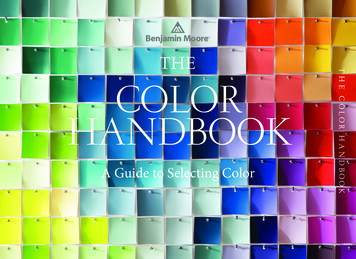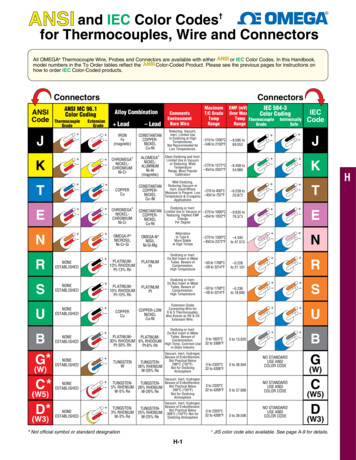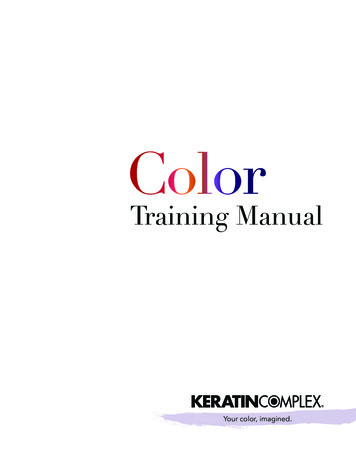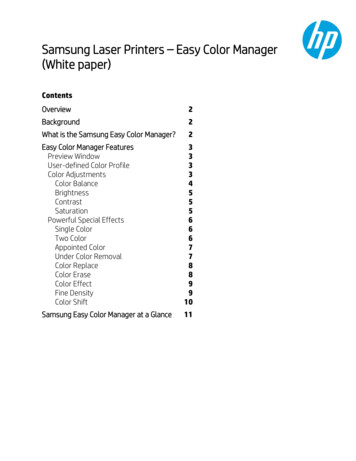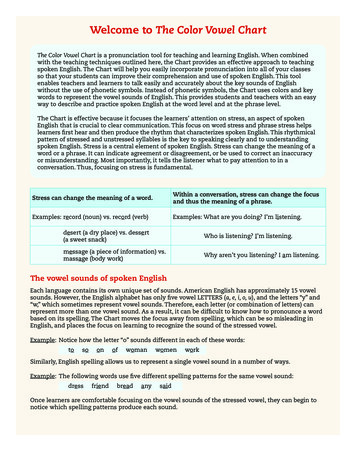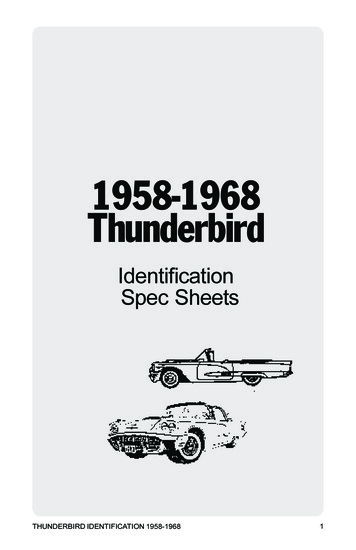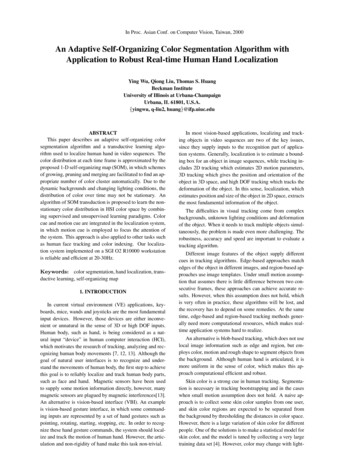
Transcription
In Proc. Asian Conf. on Computer Vision, Taiwan, 2000An Adaptive Self-Organizing Color Segmentation Algorithm withApplication to Robust Real-time Human Hand LocalizationYing Wu, Qiong Liu, Thomas S. HuangBeckman InstituteUniversity of Illinois at Urbana-ChampaignUrbana, IL 61801, U.S.A.yingwu, q-liu2, huang @ifp.uiuc.edu ABSTRACTThis paper describes an adaptive self-organizing colorsegmentation algorithm and a transductive learning algorithm used to localize human hand in video sequences. Thecolor distribution at each time frame is approximated by theproposed 1-D self-organizing map (SOM), in which schemesof growing, pruning and merging are facilitated to find an appropriate number of color cluster automatically. Due to thedynamic backgrounds and changing lighting conditions, thedistribution of color over time may not be stationary. Analgorithm of SOM transduction is proposed to learn the nonstationary color distribution in HSI color space by combining supervised and unsupervised learning paradigms. Colorcue and motion cue are integrated in the localization system,in which motion cue is employed to focus the attention ofthe system. This approach is also applied to other tasks suchas human face tracking and color indexing. Our localization system implemented on a SGI O2 R10000 workstationis reliable and efficient at 20-30Hz. color segmentation, hand localization, transductive learning, self-organizing map1. INTRODUCTIONIn current virtual environment (VE) applications, keyboards, mice, wands and joysticks are the most fundamentalinput devices. However, those devices are either inconvenient or unnatural in the sense of 3D or high DOF inputs.Human body, such as hand, is being considered as a natural input “device” in human computer interaction (HCI),which motivates the research of tracking, analyzing and recognizing human body movements [7, 12, 13]. Although thegoal of natural user interfaces is to recognize and understand the movements of human body, the first step to achievethis goal is to reliably localize and track human body parts,such as face and hand. Magnetic sensors have been usedto supply some motion information directly, however, manymagnetic sensors are plagued by magnetic interferences[13].An alternative is vision-based interface (VBI). An exampleis vision-based gesture interface, in which some commanding inputs are represented by a set of hand gestures such aspointing, rotating, starting, stopping, etc. In order to recognize these hand gesture commands, the system should localize and track the motion of human hand. However, the articulation and non-rigidity of hand make this task non-trivial.In most vision-based applications, localizing and tracking objects in video sequences are two of the key issues,since they supply inputs to the recognition part of application systems. Generally, localization is to estimate a bounding box for an object in image sequences, while tracking includes 2D tracking which estimates 2D motion parameters,3D tracking which gives the position and orientation of theobject in 3D space, and high DOF tracking which tracks thedeformation of the object. In this sense, localization, whichestimates position and size of the object in 2D space, extractsthe most fundamental information of the object.The difficulties in visual tracking come from complexbackgrounds, unknown lighting conditions and deformationof the object. When it needs to track multiple objects simultaneously, the problem is made even more challenging. Therobustness, accuracy and speed are important to evaluate atracking algorithm.Different image features of the object supply differentcues in tracking algorithms. Edge-based approaches matchedges of the object in different images, and region-based approaches use image templates. Under small motion assumption that assumes there is little difference between two consecutive frames, these approaches can achieve accurate results. However, when this assumption does not hold, whichis very often in practice, these algorithms will be lost, andthe recovery has to depend on some remedies. At the sametime, edge-based and region-based tracking methods generally need more computational resources, which makes realtime application systems hard to realize.An alternative is blob-based tracking, which does not uselocal image information such as edge and region, but employs color, motion and rough shape to segment objects fromthe background. Although human hand is articulated, it ismore uniform in the sense of color, which makes this approach computational efficient and robust.Skin color is a strong cue in human tracking. Segmentation is necessary in tracking bootstrapping and in the caseswhen small motion assumption does not hold. A naive approach is to collect some skin color samples from one user,and skin color regions are expected to be separated fromthe background by thresholding the distances in color space.However, there is a large variation of skin color for differentpeople. One of the solutions is to make a statistical model forskin color, and the model is tuned by collecting a very largetraining data set [4]. However, color may change with light-
ing conditions, which may mess up the skin color model insome cases. Another problem is that collecting such a largelabeled training data set is not trivial.Some successful tracking systems have been built basedon color segmentation [5, 3, 11, 14]. However, there aresome challenging problems related to tracking by colorbased segmentation [5], such as cluttered background withcolor distracters and changing lighting conditions.In this paper, we propose an adaptive color segmentation algorithm and a robust real-time localization system,which apply to human hand tracking and motion capturingapplications. Different from the methods of constructinga unique skin color model, our proposed approach tries toadapt the non-stationary color distributions by transducinglearned color models through image sequences. The colordistribution at each time frame is approximated by our proposed 1-D self-organizing map (SOM), by which color clusters in the HSI color space are learned through an automaticself-organizing clustering algorithm without specifying thenumber of clusters in advance. In order to capture the nonstationary color distribution, the 1-D SOM is transduced bycombing supervised and unsupervised learning paradigms.At the same time, motion cue is employed to focus the attention of the localization system. Our algorithm can also beapplied to other tracking tasks.The color segmentation algorithm based on selforganizing map and the transduction of SOM are discussedin section 2 and section 3 respectively. Our proposed handlocalization system is presented in section 4. Some experimental results are shown in section 5 and the paper is concluded in section 6.2. AUTOMATIC COLOR SEGMENTATIONColor has always been considered as a strong tool forimage segmentation [2]. In a static scene, color differenceis one of the easiest global cues to tell apart different objects. Color-based segmentation is nothing new, and its rootsare almost as old as color video itself. Even today, coloredmarkers are frequently used to facilitate locating objects in acluttered video scene.Because color is computational inexpensive, and it cangive more information than a luminance-only image or anedge-segmented image, color-based segmentation is moreattractive than edge-based and luminance histograming techniques. Histogram-like segmentation approaches such asColor Predicate (CP) [5] work well when appropriatelythresholding the histogram. Although one threshold canbe easily found in two-peak histogram that corresponds tosimple background, it is still hard to handle cluttered background because finding good thresholds can be very complicated. Another approach is to make parametric color modelsby Gaussian distribution or Gaussian Mixtures [8, 4]. Theproblem is that there is not enough prior knowledge to determine the number of components of the distribution in advance.Our color segmentation scheme is to approximate thecolor distribution of an image in the HSI color space by 1-Dself-organizing map (SOM), in which each output neuron (ornode) in SOM corresponds to a color cluster. Self-organizingmap (SOM) [6] is mainly used for visualizing and interpreting large high-dimensional data set by mapping them to lowdimensional space based on a competitive learning scheme.SOM consists of an input layer and an output layer. Figure1 shows the structure of 1-D SOM. The number of nodes ininput layer is the same as the dimension of the input vector, while the structure of the output layer can be 1-D or 2-Dconnected nodes that are connected to each input node withsome weights. Through competition, the index of the wining node is taken as the output of SOM. Hebbian learningrule adjusts the weights of the winning node and its neighborhood nodes. SOM is highly related to vector quantization (VQ) and k-mean clustering. One good characteristicsof SOM is its partial data density preservation if properlytrained. 1-D SOM structureOne of the problems of many clustering algorithms is thatthe number of clusters should be specified in advance. Thesuccess of the clustering algorithm depends on the specifiednumber of clusters. It is the same case in the basic SOM algorithm. The more output neurons, the higher the resolution,since output neurons corresponds to clusters. Different number of cluster leads to different results of tessellation of thepattern space. If less neurons are used, data of lower densitywill be dominated by the patterns of higher density. On theother hand, if more nodes are used, the ordered mapping ishard to be obtained.One possible approach to this problem is crossvalidation. Although the structure of the SOM, such asthe number of output neurons, is fixed each time, a goodstructure can be determined after validating several differentstructures. However, this approach does not offer flexibilityto find an appropriate structure of SOM, and it is not fast.An alternative is to embed some heuristics to dynamicallychange the structure of SOM in training. Our algorithm canautomatically find an appropriate number of clusters by theschemes of growing, pruning and merging.Growing Scheme: Our algorithm is also a competitivelearning scheme which deals with the problem of how to findthe competition winner. In the SOM algorithm, the outputof a node is the distance between the input vector and theweight vector of the node. The distance measurement can bedefined as:(1)"! #"% '&)( *-,., #/% '&0, ,
# &where is a distance measurement between the input vector and the weight vectorof node of SOM. The measurement here is Euclidean distance, however, other distancemeasurement can also be used.In standard SOM, the node with the smallest output istaken as the winner .12*2 3 57698 &1;: /! # % & (4these two nodes by assigning the average of the two weightsto the new node.Algorithm: The algorithm is summarized as below: Initially set the number of nodesto 2, which is according to two clusters, and randomly initialize the, whererepweightsresents the weight vector of the th node at the th iteration.(2) & * & ! ( 1 * 7 t 1# In some cases, however, when the outputs of all nodes arenearly the same, determining winner by finding the smallestoutput is not suitable. In this situation, the input vector maybe too far from every weight vector or in the center of theconvex hull of the weight vectors. If current input is includedin any of the clusters, the weight vector of that cluster will bemisplaced unnecessarily by adjusting the weight. So, it is nota robust way to make the smallest one as the winner. In thissituation, a new node could be generated by taking the inputas the weight vector of the new node, which is explained infigure 2. Draw an inputto the SOM. & ! (from the training sample set randomly Find the winner among the nodes using equation 4. neighborhood function,% 2! 22 ! ! !'#% ! ' ! ( * ( ! ( ! ! ! ( #"( % ' n ! (?* n ! ( ! (D ! ( ! #'% ! ! ( ( ' ¡ ( *p ' ¡ ( (D ( ' ¡ ( (! (! (where is the step size of learning,is aIf(winner! NULL), adjust the weights of the winnernode and its two neighborhood nodeand.is the counter of iteration.! a new# : accordingIf there is no winner, grownode * to .' (* the growing scheme.and If a node is rarely% win, delete it according to pruning * .scheme, . ? A@ BDCE F HG I J DKL B MON PRQS & GT J 'CU D J TWV XI T BY 7ZD[ F \ # G][ F .F T V DI T BD abdc XM Tfe CEJ XF T J F TWV XI T BY g G T B B M [ gM B K V X ih4C] D J T V DI T BD jG B T J [ T'T J kB T T B M[ c c F B \ # DG4[ lF D[ c h T J mG [YKR nZE M I XF T F T .Go F I c \ X\p FH[YF hqB M T J qI c G T X GXZG [ h "r Z T J pCU D J TRV DI T BD B M T J [ T I c G T X CE c cAs kKL G c [ I X\ F F DI XG G [ i c h b i J Tteku FT J .GoG T [ T B FAZA[pF DCvF Bn\ w GRI D[ T D\-[ F \ Oxy*4zBy comparing the mean value and the median value of theoutputs of all nodes, we make a rule to detect this situation.So, the competition can be described as:"! #"% '&0(D { & *(3)1 &&{where is the output of the 1 th node with weight vector .The competition winner can be found! ( by: 3}5968&0& /8} 3 k8/ } 1 3 : ! ( {*2;1: 1 :(4) q 7 t 7 57 1 Y Pruning Scheme: In the training process, when a node israrely to be a winner, it means that this cluster has very lowdensity or can be taken as noise. So, this kind of nodes canbe pruned. In practice, a threshold is set to determine suchnodes.Merging Scheme: In the training process, the distancebetween two weight vectors of each two nodes are calculated. If two weight vectors are near enough, we can mergeCalculate the distance between each two nodes andperform merging scheme.In our segmentation algorithm, training data set is collected from one color image, and each data vector isweighted HSI vector, i.e., where wesetand. Pixels with large and small intensities are not included in the training data set, because hueand saturation become unstable in this range. Once trained,the 1-D self-organizing map is used to label each pixel byits HSI value. The pixel label is the index of the node in theself-organizing map.q* 4* # * o* R § 3. TRANSDUCTION OF SOMOne of the problems of tracking by color segmentation isthat the unknown lighting conditions may change the colorof the object. Even in the case of fixed lighting sources, thecolor may still be different since the object may be shadowed by other objects. If we could find some invariants tothe lighting conditions, this problem could be easily solved.However, there are still no such invariants in the state-ofthe-art. These situations bring some difficulties to the approach of making a unique and fixed skin color model, sincethe distribution of skin color is non-stationary through image sequences so that the statistics of the distribution are notfixed.Since we neither assume static backgrounds nor fixedlighting conditions, the probability density functions of colors in a certain color space, such as HSI or normalized RGB,will be non-stationary. At each time frame, the distributionof color is modeled by the proposed 1-D SOM, in whicheach neuron represents a color cluster of current time frame.This 1-D SOM also offer a simple color classifier by competition among its output neurons, through which the image at
current time frame can be segmented. However, this classifier may not be good for the next time frame because of thenon-stationary density of color.Model adaptation over time was ever addressed in [8],in which a Gaussian mixture model was used, and a linear extrapolation was employed to adjust the parameters ofthe model by a set of labeled training data drawn from thenew frame. However, since the new image is not segmented,these labeled data set is hard to obtain.Our solution to this problem is called transduction ofSOM, which is to update the weights and structure of thetrained SOM according to a set of new training data so thatthe transduced SOM captures the new distribution. The newtraining data set in the transduction consists of both labeledand unlabeled samples. The algorithm is described below. & ª 1 * «f«t«t% t n ª are the: « «t . The trainingweights of SOM ª frameª * at# time *t t« data set is drawn ran- ªdomly from the image at time frame : . We use to represent SOM at time frameª :. The training dataset by the SOM n ª , and ª is partitioned isintoclassifiedtwo parts: a ª labeled data set# ª and an unlabeled data set n ª . If a sample is confidently classifiedby, then ª andlabelitwiththeput this sample to the set ªindex of theª winning neuron of ; otherwise, putit to and let it unlabeled. Unsupervised updating: The algorithm n ª described insection 2 is employed ª to update by the unlabeled data set . ª is Supervised updating:! # ) Thelabeled data set ª ( in this step. # is drawn from , where used # is the label for . The winning neuron for the input is 2 . ª ! # % ª ª * ª % ! # % ª ( ( 1 y2 *44* 1 % y2 ² is transAfter several iterations, the SOM at time frame :duced to : . L n ª *4. LOCALIZATION SYSTEMOur localization system is based on color segmentation.And motion segmentation and region-growing method arealso employed to make the system more robust and accuratewithout introducing too much computation cost. Figure 3shows the overview of the localization system.The first frame taken by a camera is used to initially trainthe SOM by the proposed self-organizing clustering algorithm that has been described in section 2. In this initialization stage, the color distribution in the scene is initiallymapped. In our experiments, the training is fast (less than1 sec) with a 640x480 color image. The inputs of the SOMare the HSI value of pixels, and the outputs are the indexesof winning nodes of SOM through competition. Typically, ittakes less than 6 nodes to segment indoor working environments.For each newly captured color image at time frame , theSOM is transduced by the algorithm described in section 3. R³? g B I [ c .µ¶[ T B F4G hXG T XK·M0 [ KR XCUBD i Such SOM is used to segment the input image to find different color regions. This stage can be done on a lower resolution image the make the segmentation faster. Morphologyoperators are used to get rid of noise. After each pixel hasbeen labeled, the SOM should be updated again by the supervised updating scheme described in the section 3. Thelabeled training data set is randomly selected from the segmented image, ignoring those that are too bright or dark.Since there may be many different colors in the working space, and if the system does not specify which colorto track, how to determine what to track is a problem. Onepossible solution is to specify a color region such as humanhand or face. Another solution is to use some rules to automatically find an interested color from motion intention.If we detect a motion region by examine the frame difference or optic field, the color of that region is taken to be theinterested color.There are some cases in which several objects have nearlythe same color. For instance, tracking two faces or twohands is needed in recognizing sign languages. When thecolor segmentation algorithm separates them from the background, there are some ways to locate each region. Onemethod is to use the same scheme of our self-organizingclustering to find the centroid of each isolated blob. Anotherway is to use a region-growing technique to label each blobor use some heuristics to find bounding boxes.5. PERFORMANCEOur color segmentation algorithm has been tested witha large variety of pictures. And our localization systemthat integrates this color segmentation algorithm has rununder a wide range of operating conditions. The globalhand tracking system based on our color segmentation supplies some inputs for our articulated hand motion capturingalgorithm[12]. Experiments show that our color segmentation algorithm is fast, automatic and accurate, and the proposed localization system is robust, real-time and reliable.This color segmentation algorithm can also be applied toother segmentation tasks.
¹»ºd¼ º]½ ¾ ¿YÀiÁ ¿YÂÄà Å]Æ ¾HÁ?ÀkÇ ¾nÈ ÂľnÅgÉ Ã É ÊdÁ ÅOne parameter we should specify is the maximum number of clusters. If the scene is simple, we set the maximumnumber of clusters to 2 or 3. If the scene is complex, we setit to 10 or more. In between, we use 6. . LË? ÌyB c BD ÍG D KL DF T [ T B F4 DG c T GX ' X XM TI B c KRFÎ[ G B I IXB c BY p KL[ DGXZLKR \ \ c I B c KRF [ ÏG X KR XF T D\ KR[ XGS[ F \ J TI B c KRFq[ Ð F T D XG T X\ÑI B c BY Í D B F GXFigure 4 show some segmentation results. Left columnare source color images, middle column are segmented images, and right column are separated color regions. Thecolors of segmented color regions are the average colors ofthese regions. Each pixel in the source images is assigneda label by our color segmentation algorithm, and this labelis used as a mask to separate the corresponding color region.Our segmentation algorithm works well through these experiments. When the background has less color distracters, thisalgorithm finds exact color regions. Since texture is not usedin the segmentation, segmentation results will be noisy whenthere is color distracter texture in the background. Hand andface images are taken from a cheap camera in the indoor environment in our labs. Our algorithm can also successfullysegment hand region and face region.¹»º.ÒUº]½ ¾ ¿YÀiÁ ¿DÂÏà Å]Æ ¾HÁ?À/ÓEÁ Æ Ã ÔdÊdÕ Ã É ÊdÁ ÅA typical hand-tracking scenario is controlling the display or simulating a 3-D mouse in desktop environments. Acamera mounted at the top of the desktop computer looksbelow at the keyboard area to give an image sequence ofmoving a hand. Another typical application is to track human face. Our localization system is able to simultaneouslylocalize multiple objects, which is useful in tracking of moving human.Since our localization system is essentially based on aglobal segmentation algorithm, it does not largely rely onthe tracking results of previous frames. Even if the trackermay get lost in some frames for some reasons, it can recoverby itself without interfering the subjects. In this sense, thetracking algorithm is very robust.Our proposed system can handle changing lighting condition to some extend because of the transduction of theSOM color classifier. At the same time, since the hue andsaturation are given more weight than intensity, our systemis insensitive to the change of lighting intensity such as theobjects are shadowed or the intensity of the light sourcechanges. However, there are still some problems. Insufficient lighting, too strong lighting, very dark and bright background may bring some troubles to the color segmentationalgorithm, since hue and saturation become unstable and thesystem does not give more weights to intensity. If the lighting condition changes dramatically, the color segmentationalgorithm may fail since the transduction cannot be guaranteed.One localization results of our experiments is given inFigure 5. In this experiment, a hand is moving aroundwith the interference of a moving book. The book isalso shading the light so that the color of skin is changing. The blue boxes are the bounding boxes of the interested color region. A demo sequence can be downloaded athttp://www.ifp.uiuc.edu/ yingwu.Our localization system is very robust and efficient fromthis experiment in which the background of the scene is cluttered. Since a book is interfering the hand by shading thelight, our localization system can still find a correct bounding box. Sometimes, due to the sudden change of lightingconditions, the tracker may be lost. However, it can quicklyrecover to continue working. Different skin tones do not affect our system. The first image with the interested colorregion is used to initially train the SOM so that it can workwith nearly any users, which has been tested in our otherexperiments.6. CONCLUSIONLocalization of interested objects in video sequences isessential to many computer vision applications. Clutteredbackground, unknown lighting conditions and multiple moving objects make tracking tasks challenging. Computer vision techniques supply good ways to human computer interaction by understanding the movement of human body,which requires a robust and accurate way to track the humanbody such as hand and face. This paper presented a robust
References[1] Yusuf Azoz, Lalitha Devi, Rajeev Sharma, “TrackingHand Dynamics in Unconstrained Enviornments”, International Workshop on Face and Gesture Recognition, pp.274-279, 1998[2] Dorin Comaniciu, Peter Meer, “Robust Analysis ofFeature Spaces: Color Image Segmentation” Proceedings of IEEE Conference on Computer Vision and Pattern Recognition, San Juan, Puerto Rico, June 1997,750-755.[3] Kazuyuki Imagawa, Shan Lu, Seiji Igi, “Color-BasedHands Tracking System for Sign Language Recognition”, International Workshop on Face and GestureRecognition, pp.462-467, 1998.[4] M.Jones and J.Rehg, “Statistical Color Models withApplication to Skin Detection”. Compaq CambridgeResearch Lab. Technical Report CRL 98/11, 1998[5] Rick Kjeldsen, John Kender, “Finding Skin in ColorImages” Proceedings of the Second International Conference on Automatic Face and Gesture Recognition,pp.312-317, 1996 . Ö Ø XG c T GÑB M c B I [ c µ¶[ T B FÏC T JÙ ÛÚM [ KL DG T [Y X XF M B KÜ KR[Y ÄG DÝ DF I DGX ßÞKRB V F wJ [YF \ÑCE T JÑ .F T X M X i F B M»[ s B B 4 Gc B I [ c .µ¶ X\ gàÍJ s c s BYáX DG [ T J s B F \ F s BYáoB M T J L .F T X DG T X\wIXB c BY Í X B F localization system based on self-organizing color segmentation and SOM transduction. A 1-D SOM is used to tessellate the HSI color space automatically. Images are segmented by this 1-D SOM through a competition process andeach pixel of the image is labeled by the index of the winning node. Since the lighting condition and the backgroundare not fixed, generally, the distribution of colors in the image sequence is not stationary. In order to capture the nonstationary color distribution, the 1-D SOM is transduced bycombing supervised and unsupervised learning paradigms.Experiments show that our localization system is capableof reliable tracking multiple objects in real time on oneprocessor desktop SGI O2 workstation.The transduction of SOM classifier is not mature, and itneeds more efforts to find a better way to combine supervised and unsupervised learning schemes. Since the processof competition among all nodes is essentially parallel, thetracking system can be made much faster by parallel implementation of the competition process. Currently, our localization system offers a bounding box of the interested objects. Shape analysis of localized objects will be extended toestimate the 3D motion of the objects.7. ACKNOWLEDGMENTSThis work was supported in part by National ScienceFoundation Grant IRI-9634618 and Grant CDA-9624396.[6] T.Kohonen, “Self-Organized Formation of Topologically Correct Feature Maps”, Biological Cybernetics,43:59-69, 1982.[7] Vladimir I. Pavlovic, R.Sharma, T.S.Huang, “VisualInterpretation of Hand Gestures for Human-ComputerInteraction: A Review,” IEEE PAMI, Vol.19, No.7,July, pp.677-695, 1997.[8] Y.Raja, S.McKenna, S.Gong, “Colour Model Selectionand Adaptation in Dynamic Scenes”, Proc. ECCV’98,1998[9] C.Rasmussen, G.Hager, “Joint Probabilistic Techniques for Tracking Objects Using Multiple Part Objects”, Proceedings of the Second International Conference on Automatic Face and Gesture Recognition,1998.[10] M.J.Swain and D.H.Ballard, “Color Indexing”, Int. J.Computer Vision, Vol.7, No.1, pp.11-32, 1991.[11] C. Wren, A. Azarbayejani, T. Darrel, and A. Pentland,“Pfinder: Real-Time Tracking of the Human Body”, InPhotonics East, SPIE Proceedings vol.2615, Bellingham, WA, 1995.[12] Ying Wu, Thomas S. Huang, ”Capturing ArticulatedHuman Hand Motion: A Divide-and-Conquer Approach”, IEEE Int’l Conf. on Computer Vision, Corfu,Greece, 1999[13] Ying Wu, Thomas S. Huang, ”Human Hand Modeling,Analysis and Animation in the Context of HCI” IEEEInt’l Conf. on Image Processing, Kobe, Japan, 1999[14] Ying Wu, Thomas S. Huang ”Robust Real-time HumanHand Localization by Self-Organizing Color Segmentation”, IEEE Int’l Workshop on Recognition, Analysisand Tracking of Face and Gestures in Real-Time Systems, Corfu, Greece, 1999
An Adaptive Self-Organizing Color Segmentation Algorithm with Application to Robust Real-timeHuman Hand Localization Ying W u, Qiong Liu, Thomas S. Huang Beckman Institute University of Illinois at Urbana-Champaign Urbana, IL 61801, U.S.A. yingwu, q-liu2,huang @ifp.uiuc.edu ABSTR

